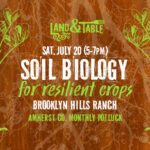Bedford County, where I live, is currently experiencing a push to change zoning regulations so that chicken and pork CAFOs (‘concentrated animal feeding operations’) can expand into the county. But what is the real impact of CAFOs and how did farming become an industrial process? Are we ready to educate ourselves on this issue or will we open a metaphorical fence gate without knowing what kind of bull is waiting to enter from the other side of the fence? The CAFO issue could easily be seen as an argument between environmentalists on one side and farmers on the other -but it is actually a conflict that involves all of us – a conflict that will shape the agricultural landscape (locally and nationally) and define the balance between farming freedoms and community health. The Farm Bureau and the EPA, two political heavyweights who have been locking horns on a myriad of farming and environmental issues are big players in these kind of issues – but at a local level these issues will be decided by county citizens – both farmers and their neighbors, who must find common ground to safeguard the health of our land and the community. It is clear to many of us though that when farming methods jeopardize the present and future health of our community – it is right and necessary to oppose and stand against zoning regulations that would favor such farming conditions. This is not the role of environmentalists but the role of everyday citizens to influence local zoning and agricultural policies that will impact all of us in many ways. So, for those of you who want to engage with this issue of expanding chicken and pork CAFOs in Bedford County I will be posting several resources that I hope many of you will consider when deciding which side of the argument you will land on. Here are some great resources from the Pew Charitable Trusts directly addressing poultry in the context of CAFO meat production (see below). From the Pew website:
“In just over 50 years, the broiler industry has been transformed from more than one million small farms spread across the country to a limited number of massive factory-style operations concentrated in 15 states,” said Karen Steuer, who directs Pew’s efforts to reform industrial animal agriculture. “This growth has harmed the environment, particularly water, because management programs for chicken waste have not kept pace with output.” …The report compiles and analyzes 50 years of federal and state government data to describe a business that has been remade by industrialization. Key findings include:+…Big Chicken describes the emergence of concentrated animal feeding operations (CAFOs) and the environmental impact of this industrial-scale production. The process creates massive amounts of broiler litter, the mix of manure and bedding taken out of the CAFO. Growers typically dispose of litter by spreading it on open fields or cropland, but when it is over-applied or poorly managed, rain washes it into streams and rivers, causing significant water-quality problems.
- In less than 60 years, the number of broiler chickens raised yearly has skyrocketed 1,400 percent, from 580 million in the 1950s to nearly nine billion today.
- Over the same period, the number of producers has plummeted by 98 percent, from 1.6 million to just over 27,000 and concentrated in just 15 states.
- The size of individual operations has grown dramatically. Today, the typical broiler chicken comes from a facility that raises more than 600,000 birds a year.
Big Chicken: Pollution and Industrial Poultry Production in America
]]>

